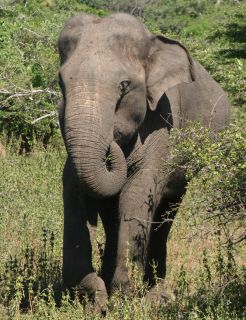 Largest, and perhaps best known of the Sri Lankan wildlife is the Asian Elephant Elephus maximus. The Asian elephant differs from its cousin, the African elephant, in several ways: the Asian is smaller, with shorter ears, a single (not double) "finger" at the end of the trunk, a more rounded back, and 4 nails, instead of 3, on its hind feet. It also has a personality that allows it to be domesticated. That is not to say that when a wild elephant chooses to cross your path in a park you don't get out of its way -- you do! Even in a big vehicle! Sir Lankan elephants don't carry a lot of ivory: most females and many of the males have no tusks at all. Asian elephants live in groups of about 10 animals led by older female. Young males are banished from the group to fend for themselves, although they often form small bachelor herds.
Largest, and perhaps best known of the Sri Lankan wildlife is the Asian Elephant Elephus maximus. The Asian elephant differs from its cousin, the African elephant, in several ways: the Asian is smaller, with shorter ears, a single (not double) "finger" at the end of the trunk, a more rounded back, and 4 nails, instead of 3, on its hind feet. It also has a personality that allows it to be domesticated. That is not to say that when a wild elephant chooses to cross your path in a park you don't get out of its way -- you do! Even in a big vehicle! Sir Lankan elephants don't carry a lot of ivory: most females and many of the males have no tusks at all. Asian elephants live in groups of about 10 animals led by older female. Young males are banished from the group to fend for themselves, although they often form small bachelor herds.Their are 2 subspecies in the country: Elephus maximus maximus (the Ceylon elephant) and Elephus maximus vilaliya (the Ceylon marsh elephant) and both are listed as endangered. It is estimated that there are perhaps 2500 wild elephants in the country now, as opposed to over 12,000 in 1900. Most live in 7 of the 10 major national parks. Wild elephants that venture into farmlands can sometimes be transported to the parks to live.


